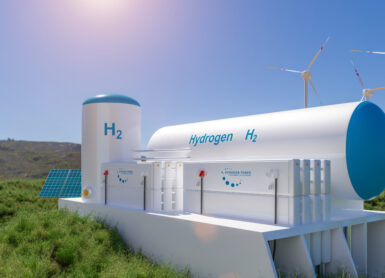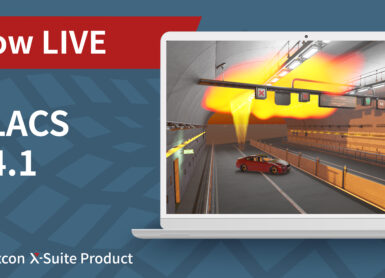

Gexcon is a prominent contributor to the IChemE community and so are excited to announce their participation in the upcoming Hazards 33 Process Safety Conference, taking place 07 -09 November 2023, Birmingham, United Kingdom.
Representing Gexcon this year is Karina Almeida Lenero – Energy Transition Technical Lead and Business Development Manager, Chris Gold – Principal Engineer and CFD Technical Lead, Graham Morrison – UK Director of Consulting, Michael Bristow – Senior Consultant and David Harding – Project Engineer.
We will detail their presentations below:
Presentation 1:
Title: To Enclose or Not to Enclose? An Investigation on the Influence of Ventilation Arrangements on Hydrogen Explosion Hazards in Compressors.
Author: Karina Almeida Lenero, Christ Gold and Michael Bristow.
Presenter: Karina Almeida Lenero
Date & Time: Wednesday 8th November 2023, 14:00 – 14:30 GMT
Abstract (Click to expand):
The aim of this paper is to provide insights into the effectiveness of different ventilation strategies and enclosure designs on the dilution of a potential hydrogen leak and thus contribute to the safe design of hydrogen infrastructure.
The use of hydrogen, in particular in highly pressurized form, is set to grow dramatically in a variety of applications. Large-scale storage is planned close to public roads, while in hydrogen refuelling stations (HRS) the public needs to be in close proximity to the hydrogen compressors and need to safely use dispensers operating at pressures as high as 700 bar. Therefore, it is essential that projects are executed and operated safely to avoid an accident that could destroy public confidence in the industry and jeopardize the license to operate for the entire sector. Of particular concern is the potential for leaks in enclosed environments originating from the very high-pressure systems typically used in hydrogen applications. In this situation, even a small leak can lead to the formation of a large flammable gas cloud which, if ignited, could result in a severe explosion.
In natural gas applications, ventilation is a well-established component of the “basis of safety” in enclosures (compressor shelters, gas turbines). However, when using hydrogen at high pressure, ventilation alone might not be enough to achieve a non-flammable atmosphere. At the Hazards 32 conference (2022), we presented a computational fluid dynamics (CFD) study of a hydrogen compressor enclosure showing that typical ventilation systems are often not sufficient to dilute a high-pressure hydrogen leak to concentrations below which no damaging overpressure are expected. One of the findings was that that particular mechanical ventilation set-up was not efficient, creating high air flows close to the inlets and outlet only, while in most of the enclosure the air speed was low. This resulted in most of the enclosure being filled with a hydrogen-air cloud close to stoichiometric concentration which, if ignited, would result in significant overpressures.
Building on the previous study, we will now show the effect of different ventilation set-ups, including local extraction ventilation where most leaks are expected and the use of a sloping roof to avoid the accumulation of hydrogen at high points. We will study how ventilation arrangements affect the size and concentration of the flammable gas cloud, and ultimately the resulting explosion overpressure.
Furthermore, this paper will explore the influence of the enclosure design itself on the accumulation of a flammable gas cloud. One common point of discussion when designing a facility involving compressors is whether these should be enclosed or not. Many vendors and process designers prefer to enclose compressors for maintenance reasons and to be able to comply with maximum allowable noise levels imposed by authorities. From the process safety perspective, however, an open design would be preferable to allow natural ventilation to help disperse the hydrogen and prevent the accumulation of large, reactive flammable gas clouds. In this study, we will compare the size and reactivity of a hydrogen-air flammable gas cloud between a fully enclosed design and one where only a roof and limited weather protection is present but allowing for enough natural ventilation around the compressor and associated piping. Finally, the ignition of the resulting flammable could from each ventilation arrangement will be simulated, to provide insight on the merits of each arrangement in mitigating the explosion hazards associated with high-pressure hydrogen compressors.
This paper will compare the effectiveness of different ventilation strategies and compressor enclosure designs on mitigating the consequences of high-pressure hydrogen leaks, thus providing a key insights for designers to facilitate the safe deployment of hydrogen in applications that inherently necessitate close proximity to the public.
Presentation 2
Title: Lessons Learned from Hydrogen System Integration.
Author: Graham Morrison and Karina Almeida Lenero.
Presenter: Graham Morrison.
Date & Time: Wednesday 8th November 2023, 15:45 – 16:15 GMT
Abstract (click to expand):
In recent years, Gexcon has increasingly been conducting safety studies for new hydrogen facilities around the world. This ranges from concept siting studies, quantitative risk assessments, CFD modelling and other safety studies, but primarily a large volume of PHA (Process Hazard Assessments).
In this presentation, we would like to share some common issues we have encountered during these projects and the learnings we have accumulated across a large number of hydrogen projects. It is hoped that other process safety professionals will be able to directly use these learnings to improve safety design on new hydrogen projects.
It is important to recognize that there are many types of companies currently engaging in the hydrogen production and delivery sectors. The companies Gexcon has dealt with fall into three main categories:
1. Large companies who already operate major hazards facilities and have already an established process safety culture.
· These companies are typically responsible for large developments, integrating production, storage and distribution of large quantities of hydrogen.
2. Entrants from other renewable sectors (e.g., wind, solar) who may not have a detailed understanding of the differences in approach between process safety vs. occupational safety.
· These groups require education to understand the challenges of handling hydrogen safely, however, are generally aware of safety issues and their potential implications.
3. New entrants, without any experience of the major hazards industry who do not have experience in process safety.
· These groups are typically responsible for small, distributed facilities, such as distributed electrolyser, compression and storage packages, or storage and dispensing packages or even storage and fuel cells.
· They often do not have an existing process safety culture and limited understanding of typical safety design processes
· They tend to have aggressive timelines for deployment
The third group will be the main focus of this presentation. In Gexcon’s experience, there are a large number of these new entrants and the same issues arise very frequently.
“Low-carbon” hydrogen production and delivery systems are typically comprised of a range of packages, each produced by a different supplier, for example:
· Electrolysers
· Compressors
· Storage
· Filling of tube trailers/storage vessels for distribution
· Dispensing for HGV or passenger cars
· Fuel cells for electricity generation
This means that, especially for smaller installations, the key task for the facility designer could perhaps be described as “system integration” rather than “system design”, in that the designer is simply providing the platform to enable the operation of the separate packages in one system.
In Gexcon’s experience, individual suppliers generally (although not universally) do a reasonable job of designing their own package such that it is self-reliant with regards to trips, interlocks and sensors (pressure/temperature/leaks). However, there are often deficiencies in the interfaces between the packages and how they all link to the overall control system.
The key issues we have noticed are:
· Lack of detailed thinking regarding the interfaces between the component packages of the system.
· A different process safety philosophy between different vendors regarding items such as trip and shutdown levels
· Lack of willingness of some vendors to share the findings of the internal PHAs they might have performed.
· Inconsistency in P&IDs/other drawings between package suppliers, leading to confusion regarding symbols, line specifications and other important details.
· Lack of consideration of lessons learned from previous similar projects between suppliers on a project level (as the forum for this to occur is often not provided early on in the project process), and potentially even on an industry level.
· A desire to produce “series manufactured” equipment (i.e., long production runs of identical equipment), constraining the end user’s ability to operate the system in the way they want, or imposing conflicts between packages.
On several occasions, it has become apparent that the workshop is the first time that suppliers have directly discussed the operation of their systems together in any significant detail, because each supplier has typically communicated with the end client individually.
In the best case, this can lead to costly re-design and project delays. In the worst case (bearing in mind the knowledge gaps noted above), this might lead to unsafe processes being put into operation.
This leads to the following key learnings, which facility designers can use to better inform the design of their facilities:
· All parties in a project need to be aware of the particular challenges associated with handling hydrogen.
· Operational and safety integration of the packages needs to be considered at an early stage of the design process. This requires an open dialogue among vendors regarding their system functionality and the client requirements.
· A process design review involving all vendors and the final operator should be performed ahead of the HAZOP. Although this is common practice when designing established petrochemical processes, it has clearly been missing in many smaller-scale hydrogen projects.
It also really highlights the importance of education, standards setting, and thought leadership by process safety professionals in order to provide a solid basis for new entrants into the market to design, procure and operate safe hydrogen facilities.
Presentation 3
Title: A Semi-quantified Method for Improving Quality and Consistency in DSEAR Assessments
Author: David Harding and Graham Morrison.
Presenter: David Harding.
Date & Time: Thursday 9th November 2023, 11:00 – 11:30 GMT
Abstract (click to expand):
The aim of the paper is to present a novel assessment methodology developed by Gexcon UK for DSEAR/ATEX risk assessments which may be of interest to those working in the process hazards industry who regularly perform DSEAR /ATEX assessments and are looking to improve the consistency and accuracy of these assessments.
In Gexcon’s experience, the majority of risk assessments performed under DSEAR are highly qualitative in nature, utilising a simple risk ranking/matrix approach. Performing qualitative risk assessments naturally results in assessment inconsistencies between engineers and companies, because while standards and guidance are available to support assessment methods, prescriptive guidance can be limited, requiring an element of engineering judgement and relying heavily of experience-based decision making.
Gexcon aims to improve on the qualitative assessment format commonly utilised during HAZOP studies and other onsite risk assessments such as DSEAR by presenting a semi-quantitative approach which has been developed as part of a cloud-based software risk assessment and reporting tool.
The methodology builds on previous published work by Gexcon (Davis et al., 2011) by applying the Layers of Protection Analysis (LOPA) method, an orders of magnitude assessment approach which does not rely on precise frequency data that is typically not available for scenarios considered during DSEAR assessments. The method guides the assessor using pre-defined decision trees applicable to each factor of the assessment: hazardous area frequency, ignition probability, consequence, occupancy, mitigation. Each end node of a given decision tree is assigned a frequency or probability value which feeds into a central risk calculation.
Assigning frequencies/probabilities to the end nodes is achieved by review of relevant technical standards, guidance documents and experience from a range of professionals in the process risk industry. This enables new users to benefit from the in-built experience of many other engineers, improving assessment accuracy and consistency across multiple industries, companies and sites.
The tool benefits users by integrating the requirements of the regulations and associated technical standards, industry guidance, key assessment considerations, relevant recommendations and actions and so forth at various stages of the decision tree process, tailored towards specific equipment, processes and industries. This reduces the likelihood that relevant assessment factors are overlooked by an assessor, improving the quality and specificity of recommendations which benefits . Additional benefits arise from the ability to query the output of each risk assessment by way of reviewing the decision tree pathway. This allows users to understand, at each stage of the assessment, the technical standards, guidance or experienced observations used to reach the final output of the risk calculation, promoting visibility of the decision making process.
Benefits for designers/equipment suppliers and site engineers include very clear zone classification, in addition to clear hierarchical recommendations. The method also has particular benefits to corporate HSE/HSEQ departments when assessing large numbers of sites, because many companies rely on sole traders or small local consultancies and when they have many sites this can result in significant variance. It is easy to build in local requirements or regulatory guidelines within the tool.
Finally, the aim for the HSE and other regulators is to produce an assessment that clearly documents the basis of safety and is rigorous in its basis and conclusions.
If you’re interested in speaking to the presenters at the conference you can arrange to meet them by clicking on the button below:
About Hazards 33
The conference holds a distinguished reputation as one of the leading global gatherings focused on process safety. First staged in 1960, the event serves as a platform to share good practice, current thinking and lessons learned in process safety, while also offering ample networking opportunities.
The themes for the event include:
- Identifying and embedding good practice in major hazard management.
- The role of executive leadership in managing major hazards.
- Understanding and managing the challenges and hazard implications of new technologies and applications.
- Identifying further opportunities for sharing and learning across industries and sectors.
Please visit their website to learn more.
Other News @gb

Gexcon to present, sponsor and exhibit at the 2024 Spring Meeting and 20th Global Congress on Process Safety.
Gexcon is pleased to announce that we will present, sponsor, and exhibit at the 2024 AIChE Spring Meeting and 20th Global Congress on Process Safety (GCPS). The event will be held on March 24 -28 at New Orleans Ernest N. Morial Convention Center,…
News @gb
Gexcon collaborate with Global R & D to present webinar | Understanding Hydrogen for Safer, Better Design and Operation.
Gexcon is pleased to announce that we will collaborate with Global R & D to deliver a knowledge-sharing webinar. Our esteemed colleague in Singapore, Richard Lee, will deliver this webinar entitled “Understanding Hydrogen for Safer, Better Design and Operation” which aims to…
News @gb
FLACS 24.1 is now live
Gexcon’s latest release, FLACS 24.1, marks a key advancement in the realms of geometry handling and fire safety simulation.
FLACS-CFD News @gb